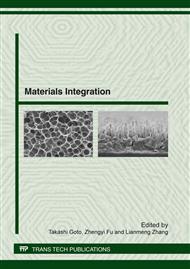[1]
R.M. Pilliar, Modern metal processing for improved load-bearing surgical implants, Biomater. 12 (1991) 95–100.
DOI: 10.1016/0142-9612(91)90185-d
Google Scholar
[2]
D. Kuroda, M. Niinomi, M, Morinaga, Y, Kato, T, Yashiro, Design and mechanical properties of new β type titanium alloys for implant materials, Mater. Sci. Eng. A 243 (1998) 244–49.
DOI: 10.1016/s0921-5093(97)00808-3
Google Scholar
[3]
M. Long, H.J. Rack, Titanium alloys in total hip replacement, a materials science perspective, Biomater. 19 (1998) 1621–39.
DOI: 10.1016/s0142-9612(97)00146-4
Google Scholar
[4]
Y. Okazaki, S. Rao, Y. Ito, T. Tateishi, Corrosion resistance, mechanical properties, corrosion fatigue strength and cytocompatibility of new Ti alloys without Al and V, Biomater. 19 (1998) 1197–1215.
DOI: 10.1016/s0142-9612(97)00235-4
Google Scholar
[5]
J.Y. Rho, T.Y. Tsui, G.M. Pharr, Elastic properties of human cortical and trabecular lamellar bone measured by nanoindentation, Biomater. 18 (1997) 1325–30.
DOI: 10.1016/s0142-9612(97)00073-2
Google Scholar
[6]
N. Sumitomo, K. Noritake, T. Hattori, K. Morikawa, S. Niwa, K. Sato, et al., Experiment study on fracture fixation with low rigidity titanium alloy, J. Mater. Sci. 19 (2008) 1581–86.
DOI: 10.1007/s10856-008-3372-y
Google Scholar
[7]
M. Nakai, M. Niinomi, X.F. Zhao, X.L. Zhao, Self-adjustment of Young's modulus in biomedical titanium alloys during orthopaedic operation, Mater. Lett. 65 (2011) 688–90.
DOI: 10.1016/j.matlet.2010.11.006
Google Scholar
[8]
T. Akahori, M. Niinomi, H. Fukui, M. Ogawa, H. Toda, Improvement in fatigue characteristics of newly developed beta type titanium alloy for biomedical applications by thermo-mechanical treatments, Mater. Sci. Eng. C 25 (2005) 248–54.
DOI: 10.1016/j.msec.2004.12.007
Google Scholar
[9]
S. Hanada, O. Izumi, Correlation of tensile properties, deformation modes, and phase stability in commercial β-phase titanium alloys, Metall. Trans. A 18 (1987) 265–71.
DOI: 10.1007/bf02825707
Google Scholar
[10]
T.S. Kuan, R.R. Ahrens, S.L. Sass, The stress-induced omega phase transformation in Ti-V alloys, Metall. Trans. A 6 (1975) 1767–74.
DOI: 10.1007/bf02642306
Google Scholar
[11]
M. Oka, Y. Taniguchi, {332} Deformation twins in a Ti-15. 5 pct V alloy, Metall. Trans. A 10 (1979) 651–53.
DOI: 10.1007/bf02658330
Google Scholar
[12]
S. Hanada, O. Izumi, Transmission electron microscopic observations of mechanical twinning in metastable beta titanium alloys, Metall. Trans. A 17 (1986) 1409–20.
DOI: 10.1007/bf02650122
Google Scholar
[13]
X.F. Zhao, M. Niinomi, M. Nakai, J. Hieda, Optimization of Cr content of metastable β-type Ti–Cr alloys with changeable Young's modulus for spinal fixation applications, (submitted for publication).
DOI: 10.1016/j.actbio.2012.02.010
Google Scholar
[14]
S. Hanada, O. Izumi, Deformation behaviour of retained β phase in β-eutectoid Ti-Cr alloys, J. Mater. Sci. 21 (1986) 4131–39.
DOI: 10.1007/bf01106518
Google Scholar


